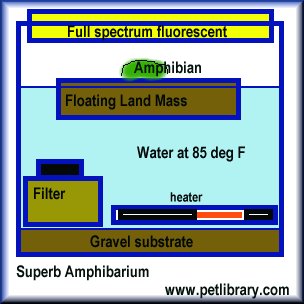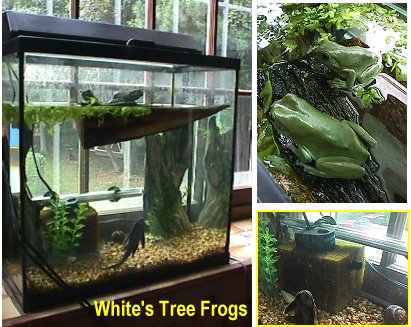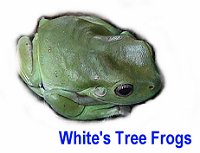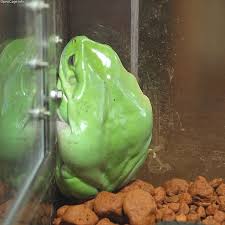 Scientists and long-time hobbyists the world over are messaging that this system is inaccurate to the White’s natural biology. They are correct. However, it is immensely successful and has been used by many people since it’s presentation. The advantages are that it is easier to heat water than air. It stays clean due to the filtration of the water. I am a veterinary clinician and treat White’s Tree Frogs every month, usually for fulminating Aeromonas boils caused by filthy water bowls, and dirty terraria. This is foreign to hard core collectors. However, the average hobbyist is not as dedicated and will do better with this effective and easy to maintain design.
Scientists and long-time hobbyists the world over are messaging that this system is inaccurate to the White’s natural biology. They are correct. However, it is immensely successful and has been used by many people since it’s presentation. The advantages are that it is easier to heat water than air. It stays clean due to the filtration of the water. I am a veterinary clinician and treat White’s Tree Frogs every month, usually for fulminating Aeromonas boils caused by filthy water bowls, and dirty terraria. This is foreign to hard core collectors. However, the average hobbyist is not as dedicated and will do better with this effective and easy to maintain design.
Keeping reptiles and amphibians over an aquatic substrate drastically improves cleanliness.
The scientific community questions this design because it is [correctly noted] foreign to the natural history of these frogs. However, it was once said that you couldn’t grow healthy tomatoes in water, too! <grin> I will upload the pics of the frogs below, as they are today. I doubt anyone would have a problem with their health.
 I am keeping my White’s in a 30 gallon tall aquarium. The tank is 3/5ths full of water, heated to 85 degrees F. I filter the water with a simple sponge filter and the frogs live hanging happily on the glass and on a log floating in the middle.
I am keeping my White’s in a 30 gallon tall aquarium. The tank is 3/5ths full of water, heated to 85 degrees F. I filter the water with a simple sponge filter and the frogs live hanging happily on the glass and on a log floating in the middle.
Common Name: White’s Tree Frog
Scientific Name: Litoria caerulea
Family: Pelodryadidae, a sub family of Hylidae (Tree Frogs)
Order: Anuran ( aka Salientia ) Class: Amphibia
Introduction: Amphibians are cold blooded, relying on the temperature of their surroundings to regulate their body temperatures. They usually have porous skin through which they are able to absorb water and oxygen, some aquatic varieties retaining gills into adulthood.
Most modern amphibians have four toed hands, and five toed feet ( often webbed).
Anurans is the proper name for both Frogs and Toads, the latter being a subset of Frogs. Frogs are generally tailless as adults, have compact bodies, and have longer more developed hind limbs than forelimbs. There are approximately 3800 different species of Anurans identified, ranging in adult size from about 1.5cm (3/8″) to 40 cm (16″) snout to vent.
Frogs are fascinating creatures due to the incredible diversity of colour, size, reproductive, predation, and survival strategies they employ.
Range: White’s tree frogs are members of family of Hylidae (Tree Frogs) and although classed under one species their is regional variation. They can be found in Northern and Eastern Australia, islands of the Torres Straits, New Guinea and parts of Indonesia. The specimens at the Valley Zoo are of the Indonesian variety and tend to be larger than the Australian variety.
Morphology: White’s tree frogs can grow up to 14cm (5.5″) for a large female, males are smaller. White’s tend to be quite plump and when healthy will have smooth body contours. White’s have the ability to change colour from a dark brown to light green, the Australian variety often tend to a bluer tone ( turquoise) and are stouter in form. White’s are covered in a thin film (coating ) which helps them retain water.

Habitat: Diverse, generally found in forested areas near a water source ( where breeding takes place). From moist tropical rain forests (New Guinea) to much dryer temperate forests in Australia. Probably due to access to water and abundance of insects are often found near human habitation.
Behaviour and Diet: White’s tend to be arboreal (live in Trees), although not exclusively. They are well adapted to tree life with long limbs, and large unwebbed hands and feet. Their fingers and toes are equipped with large suction cups for a firm hold and can climb smooth surfaces such as glass.
Being nocturnal White’s usually hide soon after sun up in a cool shaded place and become active again soon after sun down. Using the relative safety of darkness and their cryptic colouration they forage all night feeding on insects, grubs, worms, small rodents etc., eating virtually anything they can catch and fit in their mouths. They have large appetites and are usually voracious feeders.
Longevity: Known to live up to 21 years in captivity, 15 not uncommon. Life span in the wild generally much shorter due to heavy predation.
Relation to Humans: White’s are gentle and docile (except around their food) showing little fear of people. White’s have now been successfully captive bred and are available as pets. However because they require very large enclosures, special lighting, and a fair degree of up keep they are only suitable to experienced hobbyists.
 Ecology: In their native lands although not yet considered endangered, the rapid decline of suitable habitat due to human encroachment, development and pollution is causing decline in wild numbers. Conservation measures worldwide for amphibians need to be supported if we want to be able to continue to enjoy these fascinating creatures.
Ecology: In their native lands although not yet considered endangered, the rapid decline of suitable habitat due to human encroachment, development and pollution is causing decline in wild numbers. Conservation measures worldwide for amphibians need to be supported if we want to be able to continue to enjoy these fascinating creatures.
I am keeping my White’s in a 30 gallon tall aquarium. The tank is 3/5ths full of water, heated to 85 degrees F. I filter the water with a simple sponge filter and the frogs live hanging happily on the glass and on a log floating in the middle. Algae is controlled by a small plecostomus. The filter only has to cope with a few frog fecs and the wastes of the Pleco. There is full spectrum lighting in the form of a Coralife fluorescent bulb overhead, and the admitted light from the window. The frogs get Superworms [Petsmart/Armstrong’s worm farm $2.99 per 25 worms] and Crickets every day. They eat a prodigious amount. A fat frog is an expensive production.






